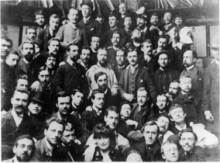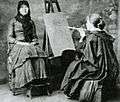Académie Julian
The Académie Julian (French pronunciation: [akademi ʒyljɑ̃])[1] was a private art school for painting and sculpture founded in Paris, France, in 1867 by French painter and teacher Rodolphe Julian (1839–1907) that was active from 1868 through 1968.[2] It remained famous for the number and quality of artists who attended during the great period of effervescence in the arts in the early twentieth century.[3][4] After 1968, it integrated with ESAG Penninghen.
 The Studio (1881) by Marie Bashkirtseff | |
| Type | Private art school |
|---|---|
| Active | 1867–1968 |
| Founder | Rodolphe Julian |
| Location | , |
History
.jpg)
Rodolphe Julian established the Académie Julian in 1868 at the Passage des Panoramas, as a private studio school for art students.[5] The Académie Julian not only prepared students to the exams at the prestigious École des Beaux-Arts, but offered independent alternative education and training in arts. "Founded at a time when art was about to undergo a long series of crucial mutations, the Academie Julian played host to painters and sculptors of every kind and persuasion and never tried to make them hew to any one particular line".[2]
In 1880, women who were not allowed to enroll for study to the École des Beaux-Arts were accepted by the new Académie Julian. Foreign applicants who had been deterred from entering the Ecole des Beaux Arts by a vicious French language examination[1] were welcome at the Académie Julian.[6] Men and women were trained separately, and women participated in the same studies as men, including drawing and painting of nude models.[7][8] "Human exchange went forward in an atmosphere that was collegial, easygoing and mutually supportive. It nurtured some of the best artists of the day".[2]
Académie Julian became popular as fertile ground with French as well as foreign students from diverse backgrounds from all over the world,[3] from the United Kingdom,[9] Canada,[10] Hungary,[11] and particularly the United States;[2][12][13] French art critic Egmont Arens wrote in 1924 that American art, at least for a period of time, reflected the teachings of Académie Julian.[14] In 1989, on the occasion of the exhibition at the Shepherd Gallery, in Manhattan, devoted to the Academie Julian in Paris as it existed between 1868 and 1939, John Russell wrote:
By my count, more than 50 nationalities were represented at the school during its glory years. To be at the Academie Julian was to be exposed to a kind of white magic that seems to have worked in almost every case. What was learned there stayed forever with alumnus and alumna, and it related as much to the conduct of life as to the uses of brush and chisel. – in The New York Times, John Russell: "An Art School That Also Taught Life", 19 March 1989.[2]
The early success of the Académie was also secured by the famous and respected artists whom Rodolphe Julian employed as instructors: Adolphe William Bouguereau (1825–1905), Henri Royer, Jean-Paul Laurens, Gabriel Ferrier, Tony Robert-Fleury, Jules Lefebvre and other leading artists of that time trained in Academic art.[15] Eventually, Académie Julian students were granted the right to compete for the Prix de Rome, a prize awarded to promising young artists.[16] and participate in the major "Salons" or art exhibitions.
In the late 19th century the term L'art pompier had entered the scene as a derisive term for the traditional academic art espoused by the Académie's instructors. As a result, the Académie Julian embraced a more liberal regime pushing a less conservative, more sincere approach to art[1] which corresponded to the Secessionist art movement in Germany and the Vienna Secession in Austria. It was followed and fully articulated by the Nabis, avant-garde movement,[17] that participated in paving the way to modern art in 1888–1889.[5]
Over time, Académie Julian opened schools in other locations. In addition to the original school at Passage des Panoramas, studios were at no. 28 Boulevard St-Jacques in the 6th arrondissement of Paris, no. 5 Rue de Berri in the 8th arrondissement, no. 31 Rue du Dragon in the 6th arrondissement, no. 51, rue Vivienne in the 2nd arrondissement for female student artists, overseen by painter Amélie Beaury-Saurel, Julian's spouse. And subsequent faculty were made up of former students, like Edgar Chahine for example.
 group of art students at Académie Julian
group of art students at Académie Julian- 'Bouguereau's Atelier at Académie Julian
 1886, group portrait, Académie Julian
1886, group portrait, Académie Julian Académie Julian
Académie Julian Marie Bashkirtseff – Académie Julian
Marie Bashkirtseff – Académie Julian Rob Wagner training at the Académie Julian in 1903.
Rob Wagner training at the Académie Julian in 1903.
Académie Julian remained open during World War I, albeit with a lesser number of students. By contrast during World War II, after the 1941 exhibition Vingt jeunes peintres de tradition française[18] considerations on "degenerate art" by the German military administration forced the school to close. In 1946 some of the studios were sold.
For his services to the arts, Rodolphe Julian, described by the Anglo-Irish novelist and critic George Moore as a kind of Hercules, dark-haired, strong, with broad shoulders, short legs, a soft voice and all the charm of the Midi was awarded the Legion of Honour.[2][19]
The artist records still extant are those of the men's section, covering the 1870–1932 period, and those of the women's section, covering the 1880–1907 period.
In 1968, an important year in France's history with the May events, particularly in relation to education, the Académie Julian integrated with ESAG Penninghen.[20]
Notable faculty and alumni of the Académie Julian
See also
References
- "académie - oi". oxfordindex.oup.com. doi:10.1093/oi/authority.20110803095345637 (inactive 7 March 2020).
- Russell, John (19 March 1989). "ART VIEW; An Art School That Also Taught Life" – via The New York Times.
- "Academie Julian: Paris Art School Founded by Rodolphe Julian". www.visual-arts-cork.com.
- Vallin, Gérard. "Elèves et professeurs de l'Académie Julian" [Students and Faculty of the Académie Julian]. academie julian (in French). Retrieved 30 September 2016.
- Tate Gallery, "Académie Julian."
- "Women of the Academie Julian - Paris - French Art". Scribd.
- Collier, Peter (30 March 1994). Artistic Relations: Literature and the Visual Arts in Nineteenth-century France. Yale University Press. ISBN 0300060092.
- Farmer, J David. "Overcoming All Obstacles: The Women of the Académie Julian – An Exhibition Organized by the Dahesh Museum". California Art Club Newsletter. No. April/May 2000. Archived from the original on 10 October 2008. Retrieved 29 September 2016.
- David Charles Rose (2015). Oscar Wilde's Elegant Republic: Transformation, Dislocation and Fantasy in fin-de-siècle Paris. Cambridge Scholars Publishing. p. 37. ISBN 978-1-4438-8360-3.
- (fr) and (en) papyrus.bib, University of Montreal
- (fr) Sophie Barthélémy, Musée d'art moderne (Céret, France), Musée Matisse (Le Cateau-Cambrésis, France), Musée des beaux-arts de Dijon, Fauves hongrois, 1904-1914
- Lubow, Arthur. "Americans in Paris". Smithsonian.
- Marshall, Bill (30 March 2019). France and the Americas. ABC-CLIO. ISBN 9781851094110.
- (fr)La Renaissance de l'art français et des industries de luxe, 1924
- (in French) Gallica, French-archives, Les plaisirs et les curiosités de Paris, 1889, p. 193
- Chilvers, Ian, ed. (2004). "Académie," Oxford Dictionary of Art, p. 5–6., p. 5, at Google Books
- artuk.org, student Ludwig Meidner (...) was unaffected by avant-garde developments there.
- Oxfrord index Peintres de Tradition Française
- "JULIAN, Rodolphe (1839 - 1907), Painter, engraver, illustrator : Benezit Dictionary of Artists - oi". oxfordindex.oup.com. doi:10.1093/benz/9780199773787.article.b00096321.
- penninghen.com, historique, From Académie Jullian to ESAG Penninghen
Bibliography
- (fr) Martine Hérold, L’Académie Julian a cent ans, 1968 [brochure commémorative des 100 années de l'Académie Julian]
- Catherine Fehrer, "New Light on the Académie Julian and its founder (Rodolphe Julian)", in La Gazette des Beaux-Arts, mai-juin 1984.
- Catherine Fehrer, The Julian Academy, Paris, 1868-1939 : spring exhibition, 1989, essays by Catherine Fehrer ; exhibition organized by Robert and Elisabeth Kashey, New York, N.Y. (21 E. 84th St., New York) : Shepherd Gallery, vers 1989 [incluant la liste des artistes ayant fréquenté l'Académie ainsi que des professeurs].
- (fr) Larcher, Albert, Revivons nos belles années à l'Académie Julian 1919-1925, chez l'auteur, Auxerre, 1982.
- "Women at the Académie Julian in Paris" in The Burlington Magazine, Londres, CXXXVI, novembre 1994.
- Gabriel P. Weisberg and Jane R. Becker (editors), Overcoming All Obstacles : The Women of the Académie Julian, Dahesh Museum, New Brunswick, Rutgers University Press, New Jersey, 1999.
- Reid, Dennis R. (1988). A Concise History of Canadian Painting. Toronto: Oxford University Press. ISBN 978-0-19-540664-1; ISBN 978-0-19-540663-4; OCLC 18378555
External links
| Wikimedia Commons has media related to Académie Julian. |
- Vallin, Gérard. "Elèves et professeurs de l'Académie Julian – Introduction" [Students and Faculty of the Académie Julian – Introduction]. academie julian (in French).
- Etching by Rodolphe Julian from the De Young (museum) collection
- Académie Julian - Global Britannica , (registered members)